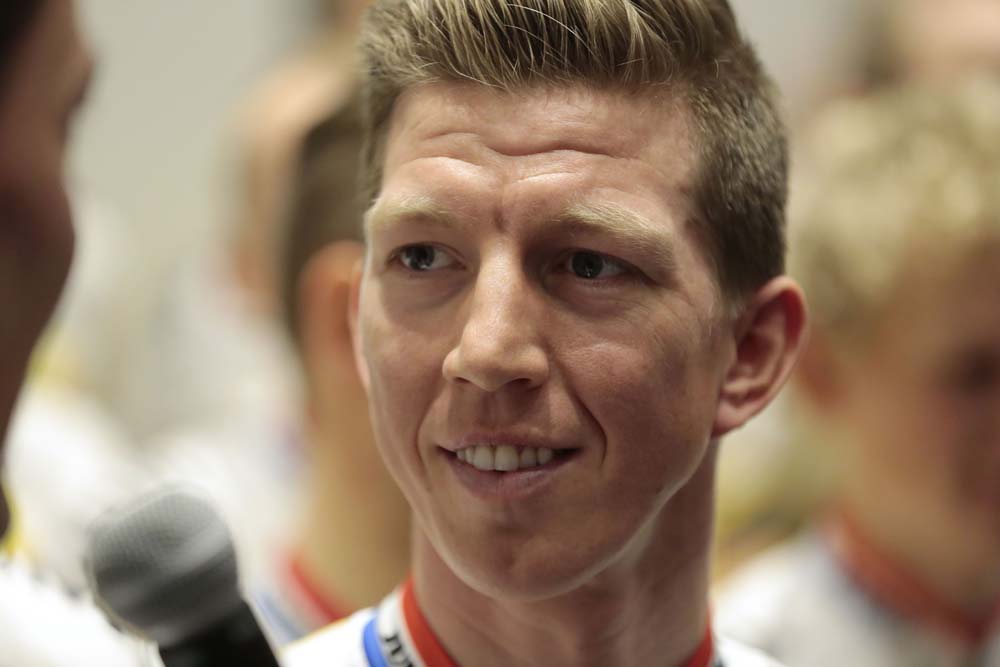Vanmarcke content with second place behind Sagan at Gent-Wevelgem
'I gave a lot to stay up front,' says LottoNl-Jumbo rider





One of the abiding images of last year’s Tour of Flanders was the sight of Sep Vanmarcke, the leading home contender, giving a forlorn, lone chase after being surprisingly dropped by the peloton on the slopes of the Taaienberg, long before the race’s endgame had truly begun.
There must have been an uneasy feeling of déjà vu for Vanmarcke at Gent-Wevelgem on Sunday when he failed to make the 34-rider leading group that formed when the peloton split in crosswinds with some 130 kilometres still to race.
To place second in Wevelgem after such an inauspicious start, then, will surely have been a boon to Vanmarcke’s often fragile confidence ahead of next Sunday’s Tour of Flanders. Certainly, that misstep apart, there were largely positive auguries to be drawn from the LottoNL-Jumbo man’s display here.
After a frantic, hour-long chase in the second echelon, Vanmarcke bridged up the leaders with 90 kilometres remaining. He proceeded to launch a searing attack on the penultimate climb of the Baneberg and was then the only man who could follow eventual winner Peter Sagan (Tinkoff) and Fabian Cancellara (Trek-Segafredo) on the final ascent, the Kemmelberg.
“It didn’t start well for me,” Vanmarcke said afterwards with considerable understatement. “Beforehand, we knew that there were going to be crosswinds. I was well positioned at the turn, but it was my own fault because I dropped back after that when nothing happened. Suddenly, it completely split up. From there it was a chase for me. I made up a lot of ground and got into the second echelon, but it was a long pursuit from there.”
Vanmarcke, like everybody else, wasn’t able to hold the wheels of Cancellara and Sagan as they bounded up the final ascent of the Kemmelberg, but he managed to keep their coattails just about within clutching distance as he crested the summit.
“I knew that I had to take the corners in the descent of the Kemmelberg at full risk because if the gap wasn’t closed straight away, it would be over,” he said. “I only just managed to do it.
The latest race content, interviews, features, reviews and expert buying guides, direct to your inbox!
“During the pursuit today and at the Kemmelberg I felt that I was strong. I knew I lost a few bullets in the pursuit but I knew that I would still be riding the finale today, though I didn’t expect to be up there with the two best riders.”
The trio picked up earlier attacker Viacheslav Kuznetsov (Katusha) on the long, flat run-in to Wevelgem and despite Etixx-QuickStep’s efforts at the head of the chasing group, it soon became clear that they would not be reeled back in again before the finish.
Vanmarcke was not among the fastest riders in the group by reputation – he has twice lost sprints to Cancellara with Monuments on the line, after all – but he admitted that he couldn’t even entertain the idea of trying to attack alone in the closing kilometres.
“They ride very hard,” he said of Cancellara and Sagan. “I was the weakest from the three when taking pulls. I can admit that. There’s no shame in that: it was a world champion and a man who has probably won ten classics and been the world time trial champion.”
In the final, four-up sprint, it was Kuznetsov who blinked first and opened his effort from distance. Sagan overhauled him to prove an emphatic winner, but Vanmarcke declared himself content to come away with second place.
“I was dead. I gave a lot to stay up front. I know that I have a bit of a sprint at the end of a race but to beat Sagan and Cancellara is hard. I’m pleased with second place,” he said.
“Sometimes they say second place is the most thankless position, but I’m pleased to finish second today instead of third. I narrowly missed out on the podium in Harelbeke in a similar position, but now I’ve taken second place with a simple bike throw. That’s often taken for granted.”
The success or failure of Vanmarcke’s spring, of course, will not be measured by a podium finish at Gent-Wevelgem, or a promising showing at E3 Harelbeke, of course, but by how he fares in the white heat of the Tour of Flanders and Paris-Roubaix. After last season’s travails, when, by his own admission, he burdened himself with too much expectation, Vanmarcke will come away from Wevelgem with some confidence restored.
“It was the goal to be good now, and you’ve got to be happy when it works out in a good way too,” Vanmarcke said. “It’s just in time.”
Subscribe to the Cyclingnews video channel.
Click here to subscribe to the Cyclingnews podcast.

Barry Ryan was Head of Features at Cyclingnews. He has covered professional cycling since 2010, reporting from the Tour de France, Giro d’Italia and events from Argentina to Japan. His writing has appeared in The Independent, Procycling and Cycling Plus. He is the author of The Ascent: Sean Kelly, Stephen Roche and the Rise of Irish Cycling’s Golden Generation, published by Gill Books.